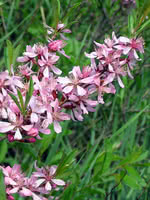Mon-Fri 9am - 5pm Mountain time
Russian Almond vs Wild Snowberry
Prunus tenella
Symphoricarpos spp.
CUSTOM GROW
Russian Almond is a low maintenance, short, slightly suckering shrub. It is covered with attractive, bright pink flowers in early spring before its foliage emerges.
This hardy species forms dense thickets attracts wildlife. Russian Almond prefers full sun and well-drained soils, but can tolerate moist soils.
The nuts it produces are quite attractive but very small. They are bitter and possibly toxic in large quantities.
Check out our YouTube channel video of the Russian Almond here.
Wild Snowberry is a mix of Common Snowberry and Western Snowberry. Each shrub's size, flower, and berry colour may vary.
This plant is abundant across the prairies. It can be planted alone or as a hedge in small yards. This shrub's ornamental berries persist into winter. Wild Snowberry can be a natural habitat and food source for various animals.

